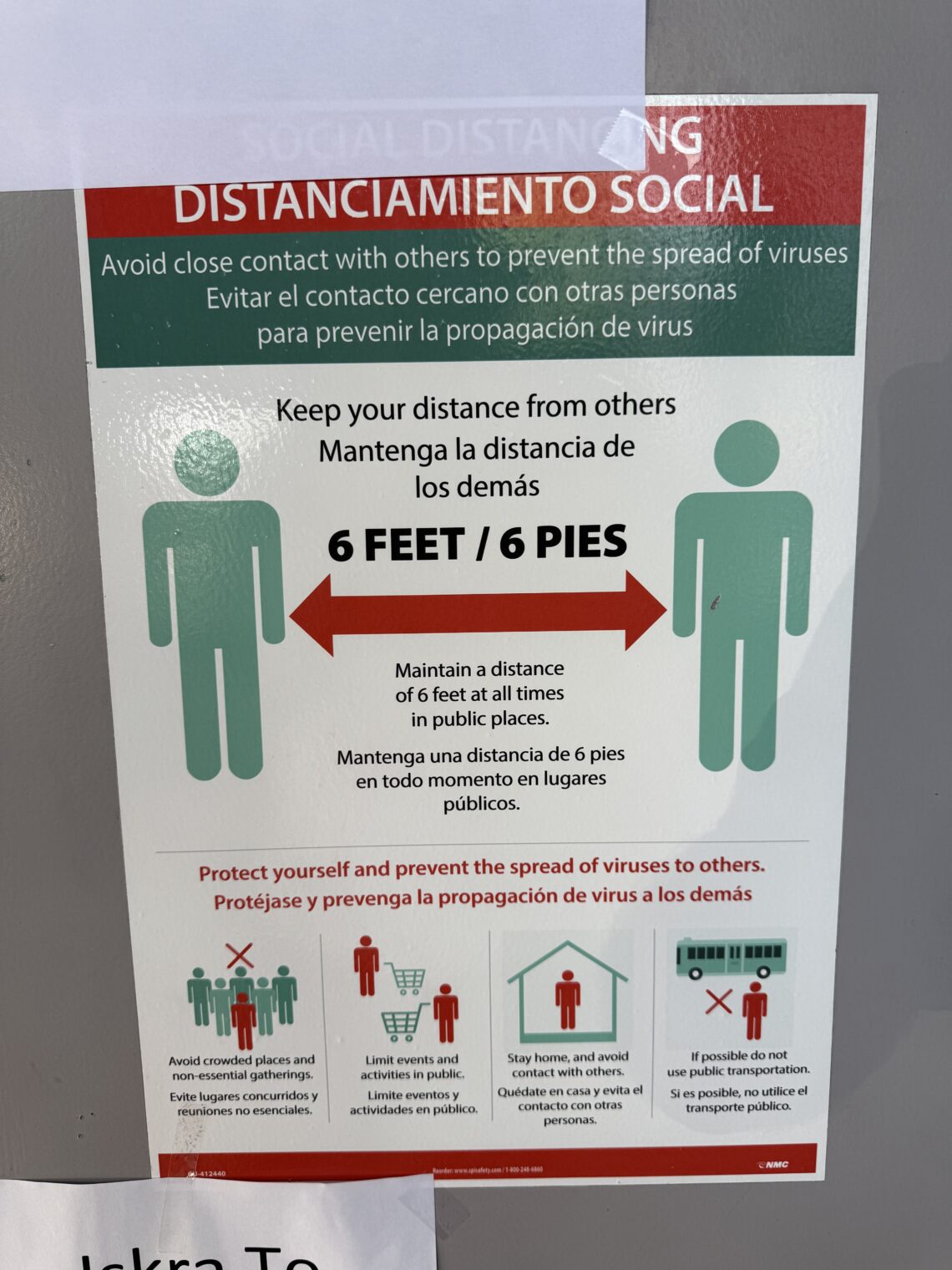Most of the lectures at Sun ‘n Fun happen in a modern air-conditioned building that belongs to Central Florida Aerospace Academy, a public high school. Fittingly for today’s topic, one enters the building via a door that features a coronapanic sign:
(See When will we feel safe enough to remove our coronapanic signs? (2024))
The presenter was Dr. Daniel Monlux, the kind of physician that noble aid recipients in the Middle East, accustomed to free food, education, health care, etc., probably wouldn’t ask to see twice (he was in the F/A-18 in the U.S. Navy). Dr. Monlux is a founder of Wingman Med, a consulting firm that helps pilots maintain their medicals.
The most important take-away from the talk is that every pilot should get certified under BasicMed even if he/she/ze/they also holds a conventional medical certificate. That way, if there is a hiccup in the medical renewal process, the pilot can still fly his/her/zir/their family around in a Cessna or Cirrus. There is no obstacle to dual medical certification.
What can go wrong in the medical renewal process? If the pilot discloses a new condition of some sort (the FAA doesn’t normally have access to a pilot’s medical records other than self-disclosure, according to Dr. Monlux) and that new condition isn’t on the “CACI list” or the pilot doesn’t have the right documentation for the AME (Aviation Medical Examiner) to issue a medical under CACI then there will be a deferral.
First, how can the pilot avoid a deferral? One way is to look at the CACI list web pages and figure out what the AME will need to see. Typically it is a report from a physician (not a nurse-practitioner or PA) within 90 days of the aviation medical exam.
Suppose that there is a deferral? Then the pilot is plunged into a hellish holding pattern. Mostly this is not due to the low-paid doctors employed by the FAA in Oklahoma City wanting to torture pilots, but rather because the FAA is required by regulation to use only USPS and hardcopy letters for communicating with pilots. It takes 2-3 months for a hardcopy mail exchange to occur. If the pilot hasn’t given the FAA exactly the information requested in the format that is requested, there will be at least another 2-3 months of delay. (no need for a DOGE reengineering here!)
Pilots often make things worse during this process. They will submit more information that the FAA requests, e.g., a full medical record from a provider that happens to have a medication list and a condition list. Invariably, these lists at medical institutions are out of date and contain conditions and medications that are no longer relevant, but once the FAA sees any of them they will need an explanation (from a physician within the past 90 days) about why the condition no longer exists and the medication is no longer being taken.
These processes can drag on for years and there is a plan for the FAA to start denying medical applications, rather than simply continuing the deferral farce, if the pilot can’t get organized to supply everything that the FAA needs (could be challenging in a country where it can take 3-4 months to get an appointment with a specialist). If the FAA actually denies a medical certificate then the pilot can’t continue to fly under BasicMed.
As noted above, most problems in this domain are self-inflicted. However, in the event of a complaint by a copilot, for example, the FAA does have access to prescription drug databases and might be able to see, for example, that a pilot was prescribed opioids (America’s favorite pastime) or anti-psychotic drugs.
Let me close with a trendy new topic: What if you’re a massive beefcake and decide to slim down via Ozempic or similar? Make sure that it is prescribed for weight loss, not diabetes! Diabetes is a matter of serious concern to the FAA because, among other things, it can affect vision.
Readers: Who has been on Ozempic or a competitive GLP-1 inhibitor? I have a few friends on them and everyone seems happy in their new thin guise. Is Elon Musk right that everyone should be on them? I would have to lose 20 lbs. to get into what the government says is an ideal weight range. As long as our house is within 15 minutes of Costco, I don’t see that happening absent Ozempic and, at the same time, I hate the idea of giving myself injections almost as much as I hate the idea of grueling exercise.
Speaking of Ozempic, here’s where I got lunch:


I would strongly recommend against the Ozempic: some people think that it might be as “safe and effective” as the COVID-19 mRNA.
First, looking only at height-weight charts is stupid. You need to consider body composition. One cheap way is to get a “Myotape” at Amazon and a scale and use the Navy method (e.g.https://www.bizcalcs.com/body-fat-navy/ ; click “Male” first, assuming that you still identify that way), My Python module is available upon request.
In addition to all the horrific “side effects” like blindness and digestive system issues, it will probably cause muscle loss, which is much worse for your health (including future obesity) than losing a few pounds.
I haven’t researched this in my usual depth. But I know enough to know that the costs are high and the benefits low.
“risks”, not “costs”
But it’s a money-spinner, no?
Just pray against the day the CDC makes it ‘mandatory’.
CCR: when you consider the widespread impact on public health and that obesity is contagious it absolutely makes sense to coerce people into taking it using the same methods we used to force masking and COVID-19 vaccination. Also would make sense to close schools in any place where a lot of kids are fat (so thin kids don’t learn that being fat is normal).
https://news.harvard.edu/gazette/story/2007/07/obesity-is-contagious/
I tried Rybelsus (ozempic in pill form) and now on Zepbound (last-generation ozempic).
Basic effect is that it removes “food noise” – which you don’t know you have until you try it. Basically it removes this desire to it more or to eat snacks which you constantly have on the back of your mind.
But it requires management – eating too little will lead to muscle loss, so you still want to eat reasonable amounts, enough protein, and loose weight through exercise.
My success is moderate, because my recovery from exercise is shit. Reality is that at my age I also need TRT (another life changing/aging delaying treatment everybody is raving about). I’m going to do it (injections). I already tried supplements, and wow, when they work, they work.
I highly recommend ozempic and friends to everyone at least to try to understand what it is about and then decide for themselves.
How well does the pill form work compared to injections?
It works, but somewhat uneven, which I attribute to variations in delivery: you have to take it in the morning on empty stomach with small amount of water and not consume anything else for 30 min. Obviously this has high variability. It also takes some time to build up since it has half-life of one week. Essentially you get to your full dose after one month of taking it. Novo Nordisk has great very detailed documentation, btw.
Using auto-injector is trivial, and then you just ride the wave for one week until next injection.
On the other hand advantage of daily pills is that you can tweak the dose much faster. For example, right now I’m on 12.5 of zepbound, and it seems that I built up too much of it – I don’t want to eat at all, which is a bit of problem to get the macros in for exercising (nice problem to have, as they say). I’m thinking about going back to 10mg, but this adjustment will take weeks. (Partially due to the fact that they come in packs of 4 injectors).
Anyway, I have better success with injectors, but pills is a good easy start. I was buying mine in Mexico and Canada. Now Zepbound is insurance-covered. As usual, they run “refund scum” aka discount on their website, so after I registered copay is only $20!
(Also, not sound as broken record: measure you testosterone, to get thinner your need your metabolism on normal level, which might not happen without TRT, I’m doing this next)
Given how widespread obesity is, why isn’t Ozempic as accessible as healing-marijuana? Seems like a no-brainer if we are serious about obesity. No?
It’s available, but expensive. Why? Because USA. You can buy 3x cheaper from Mexico or Canada or 5x cheaper god-knows-what Chinese version online.
Been on Wegovy for about ten months (same thing as Ozempic but Ozempic is prescribed for diabetes, Wegovy for weight loss).
Like previous commenter said, removes the background concentration on food that my brain saddles me with normally. I’ve lost some weight and it has been effortless.
Few side effects… I get heartburn/acid reflux now, where I didn’t used to. I’ve started taking a few Tums before bed and that almost always keeps it in check.
No problem injecting my gut once a week. Barely feel it.
Be homeless for a year. Best shape of my life.
As for the annoying regulations:
https://www.regulations.gov/deregulation
Unless you are highly averse to needles, the one used by Ozempic is negligible. It uses a 32 gauge, 5/32 inch needle